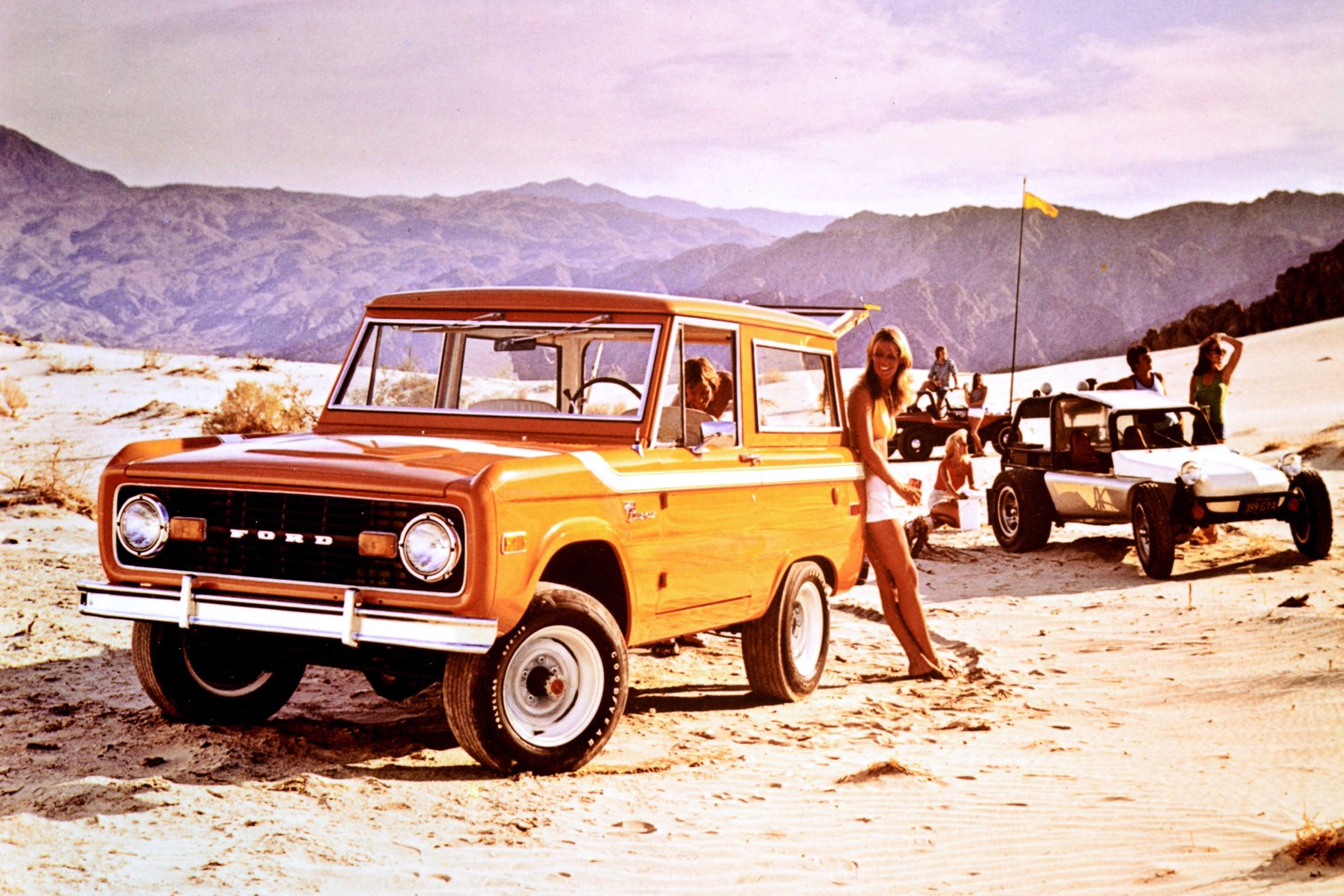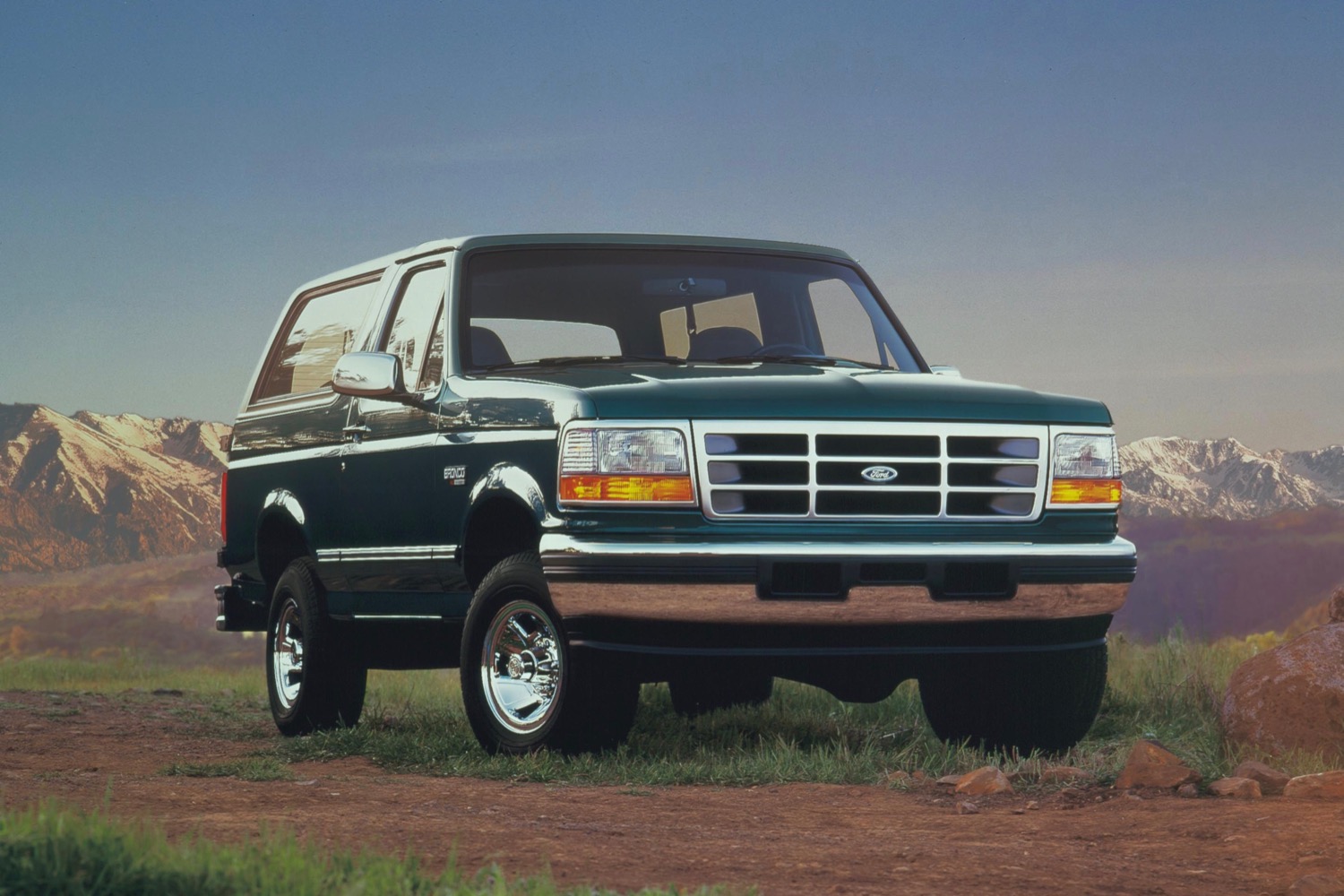The 2021 Ford Bronco marks the return of the Blue Oval’s original SUV after 24 years away. The original Bronco helped create the template for the modern SUV, combined rugged construction with everyday practicality. Here’s how the Bronco made automotive history, and why it took Ford so long to bring it back.
Bronco prehistory
Ford didn’t invent the SUV, but executives knew a trend when they saw one. Just as the 2021 Bronco targets the Jeep Wrangler, the original Bronco targeted the Jeep CJ, the brand’s first civilian model. Ford actually built Jeeps during World War II alongside Willys Overland (you can spot a Ford-built Jeep by the letter “F” stamped into most parts), but after the war, Willys retained the rights to the design.
1965-1977: First generation
Former G.I.s began buying military surplus Jeeps, as well as Willys-manufactured civilian models, but Ford thought it could do better.
Unveiled on August 11, 1965, the first-generation Bronco followed the Jeep example with standard four-wheel drive and a short wheelbase for better maneuverability off-road. However, Ford also focused on road manners to make the Bronco more of an everyday vehicle. A 1966 press release described the Bronco as a “sports-utility vehicle” — one of the earliest uses of that term.
The first-generation Bronco was available in three body styles: Wagon, convertible “roadster,” and pickup truck. At launch, the Bronco was powered by a 105-horsepower 2.8-liter inline-six engine, coupled to a three-speed manual transmission. More powerful V8 engines were added later in the production run.
The Bronco had its moment of glory at the 1969 Baja 1000, winning the legendary Mexican off-road race. Ford tried to repeat that success in 2019 for the 50th anniversary of that win, but things didn’t work out. The Bronco R racer didn’t even finish due to reliability issues.
1978-1979: Short-lived second generation
The second-generation Bronco only lasted two model years, but it was a major evolution of the species.
Where the first-generation Bronco had a unique platform, Ford decided to save some money and use a shortened version of the F-100 pickup truck platform for the second-generation model. Rival General Motors had done the same thing, turning the C/K pickup truck into the Chevrolet K5 Blazer. Chevy recently revived the Blazer name, but for a very different kind of vehicle that doesn’t compete directly with the 2021 Bronco.
The result was a much bigger vehicle than the original Bronco, and with only one available body style: A two-door with a removable hardtop. The engine lineup was V8 only, but that didn’t mean buyers were treated to copious amounts of power. The most powerful engine made just 149 hp.
While the first-generation Bronco made headlines in motorsports, the second-generation model had a somewhat different claim to fame. Three Broncos were converted into Popemobiles for Pope John Paul II’s 1979 United States visit. The SUVs got white paint and rear platforms to give the Pontiff maximum visibility.
1980-1986: Bigger and smaller
The third-generation model retained its predecessor’s generous proportions, but Ford at least reduced weight. The Bronco was still based on the F-100 pickup, but Ford swapped the solid-axle front suspension for an independent setup to improve on-road ride and handling.
Ford also brought back the inline-six base engine, this time with 4.9 liters of displacement and just 115 hp. V8 engines remained available as well, including a 5.8-liter unit making 210 hp. As with the third-generation Bronco, the only body style was a two-door with a removable hardtop.
In 1984, Ford launched the Bronco II as a little sibling to the standard Bronco. Based on the Ford Ranger pickup truck, the Bronco II remained in production until 1990. Just as the Bronco itself is coming back, the Bronco II gets a spiritual successor in the form of the 2021 Ford Bronco Sport, a smaller model launching alongside the 2021 Bronco.
1987-1991: Minor changes
The 1987-1991 Bronco may look different, thanks to a smoother front end inspired by the F-150 pickup truck, and is considered a distinct Bronco generation, but it didn’t bring many changes beyond styling.
The interior was restyled, and Ford added a more modern electronic setup for the four-wheel-drive system. In another nod to modernity, the 4.9-liter inline-six and 5.8-liter V8 engines got fuel injection.
Aside from those changes, the Bronco remained largely unchanged from its 1960s and 1970s predecessors. That would become a problem as buyer tastes changed.
1992-1996: End of the trail
The fifth-generation Bronco once again borrowed styling and a basic platform from the F-150. Ford attempted to improve safety by adding crumple zones and, for the 1994 model year, a standard driver’s airbag. The top was still technically removable, but the center brake light and rear seatbelts were mounted to it, effectively making removal impossible.
O.J. Simpson made this generation of Bronco famous (or infamous, depending on your perspective), thanks to a 1995 police chase on Los Angeles’ Interstate 405. Ford was forced to postpone the reveal of the 2021 Bronco because the original date was Simpson’s birthday.
This generation of Bronco would be the last for over two decades, thanks to competition from within the Ford brand. Launched in 1991, the Ford Explorer was built for off-roading, but was better at tackling school runs and shopping trips than the Bronco. The Explorer represented the next evolutionary stage of SUVs, and made the Bronco look like a dinosaur.
Bringing back the Bronco
As mainstream SUVs like the Explorer evolved to better suit their natural habitats — suburban parking lots — a niche for a more rugged, back-to-basics off-roader began to open up. As with the original Bronco, though, Ford found itself responding to Jeep rather than blazing its own trail.
As Ford prepared to retire the Bronco, sales of the Jeep Wrangler began picking up speed. While Ford unveiled a Bronco concept car in 2004, it continued to focus on more conventional SUVs, as well as its bestseller, the F-150. Conventional wisdom said buyers wanted more comfort and convenience. Even the Explorer gradually lost most of its off-road capability, as that was no longer important to most buyers. Yet the old school Jeep Wrangler continued to sell in droves and, just like in the 1960s, Ford thought it could do better.
Ford finally announced a new Bronco in 2017, but took its time rolling out the new SUV. The 2021 Ford Bronco and Bronco Sport will be unveiled on July 13. Stay tuned for full details.







